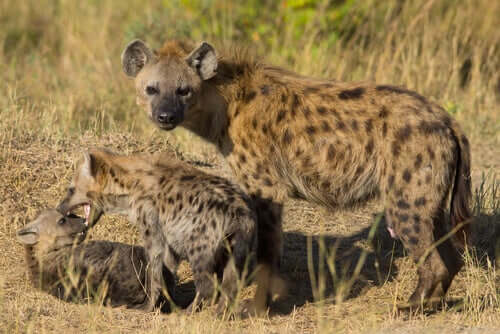The Habitat, Behavior, and Characteristics of Hyenas

All of us are familiar with the hyena – an animal that many cultures consider to be demonic. This is understandable, given their disturbing smiles and their howls that sound like human laughter. But did you know that there are actually four different hyena breeds in existence? Today we’ll take a look at the habitat, behavior, and characteristics of hyenas, including the particularities of each breed.
The hyena
The Hyaenidae is one of the smallest mammal families. It consists of only four subspecies that are distributed throughout the African continent, Central Asia, and India. They are similar to dogs in appearance, but also share some characteristics with cats. However, hyenas are a different animal altogether.
These animals fulfill a specific function, just like any other being in nature. They are scavengers, meaning that they eat the remains of animals that other predators (such as lions or cheetahs) have left behind. In this sense, they help to clean their environment and prevent infections in their ecosystem… much in the same way that vultures do.
On some occasions, hyenas may steal the prey of other animals. In fact, they are capable of intimidating lions when they attack alone.
All that being said, hyenas aren’t just scavengers. The members of this species are the second largest hunters in Africa, just behind the African lion. If they can’t find a dead animal to devour, then they will go after smaller animals, such as rats, birds, snakes, and insects.
The characteristics of hyenas
As we mentioned above, there are four different species of hyenas in existence around the world. First of all, we have the spotted hyena (Crocuta crocuta), also known as the laughing hyena, which we find in Africa. This is the hyena breed that people are most familiar with. However, the aardwolf (Proteles cristata) also lives in southern Africa.
Finally, we also have the striped hyena (Hyaena hyaena) and the brown hyena (Hyaena brunnea). These last two breeds inhabit India and the Middle East.
These animals are very hairy and medium in size. They measure no more than 28 inches in width and are no more than 60 inches long. The heaviest specimens weigh less than 180 pounds. Just the same, they are truly terrifying animals.
The habitat of hyenas
Usually, hyenas can be found in the flatlands of Africa. However, they also live in the deserts of Arabia, the flatlands of the Middle East, and the plains of India. Their favorite terrains are dry, with high temperatures and a moderate concentration of animals.
Hyenas tend to live close to lakes and rivers where they can hide the leftovers that remain from their successful finds. What’s more, it’s a matter of strategy. Animals approach the water, giving hyenas the opportunity to hunt rather than scavenge.
In general, these mammals tend to hunt at night, being nocturnal animals. On rare occasions, they may venture out during the early morning hours when other predators begin their daily hunting.
The behavior of hyenas
The characteristics of hyenas that make them most terrifying are their social habits. They are able to communicate with one another and coordinate movements in groups as large as 40. This fact, along with their powerful mouths, makes them extremely dangerous, capable of crushing bones with their sharp fangs.

A matriarch tends to lead hyena packs, although she participates very little in the actual hunting. Unlike other carnivores, when it comes to hyenas, the job of hunting belongs primarily to the males.
However, not all hyenas are aggressive. In fact, they tend to be rather cowardly, never attacking when on their own. Rather, they always attack in number in order to feel safe. On many occasions, they retreat as quickly as possible when they feel under threat.
Striped hyenas and brown hyenas are not at all aggressive in comparison to the African spotted hyena. These two subspecies rely almost exclusively on scavenging in order to eat. As for aardwolves, they feed mostly on insects, thanks to their viscous tongues. They also eat rodents and birds.
During their reproductive season, hyenas have a relatively short gestation period. It lasts approximately 95 days in all four hyena species. It’s also interesting to know that females of the spotted hyena species possess a reproductive organ that is similar to the penis of their male counterparts.
Curiosities
- Hyenas have appeared in movies like The Lion King, where a trio of these animals helps break the tension between scenes.
- Ancient human tribes believed that hyenas carried with them the souls of the dead. Therefore, they stayed as far away from them as possible, believing them to be demonic.
- Some religions today consider hyenas to be a taboo species, given their almost identical sexual organs.
And lastly, it’s worth pointing out that many consider the aardwolf and the African wild dog to be a separate species within the Hyaenidae family. Whatever the case may be, it’s an undeniable fact that hyenas possess many striking characteristics and a surprising predator instinct.
All cited sources were thoroughly reviewed by our team to ensure their quality, reliability, currency, and validity. The bibliography of this article was considered reliable and of academic or scientific accuracy.
- Semenov, Y. (2008). Taxonomical reappraisal of “ictitheres”(Mammalia, Carnivora) from the Late Miocene of Kenya. Comptes Rendus Palevol, 7(8), 529-539.
- Turner, A., Antón, M., & Werdelin, L. (2008). Taxonomy and evolutionary patterns in the fossil Hyaenidae of Europe. Geobios, 41(5), 677-687.
This text is provided for informational purposes only and does not replace consultation with a professional. If in doubt, consult your specialist.